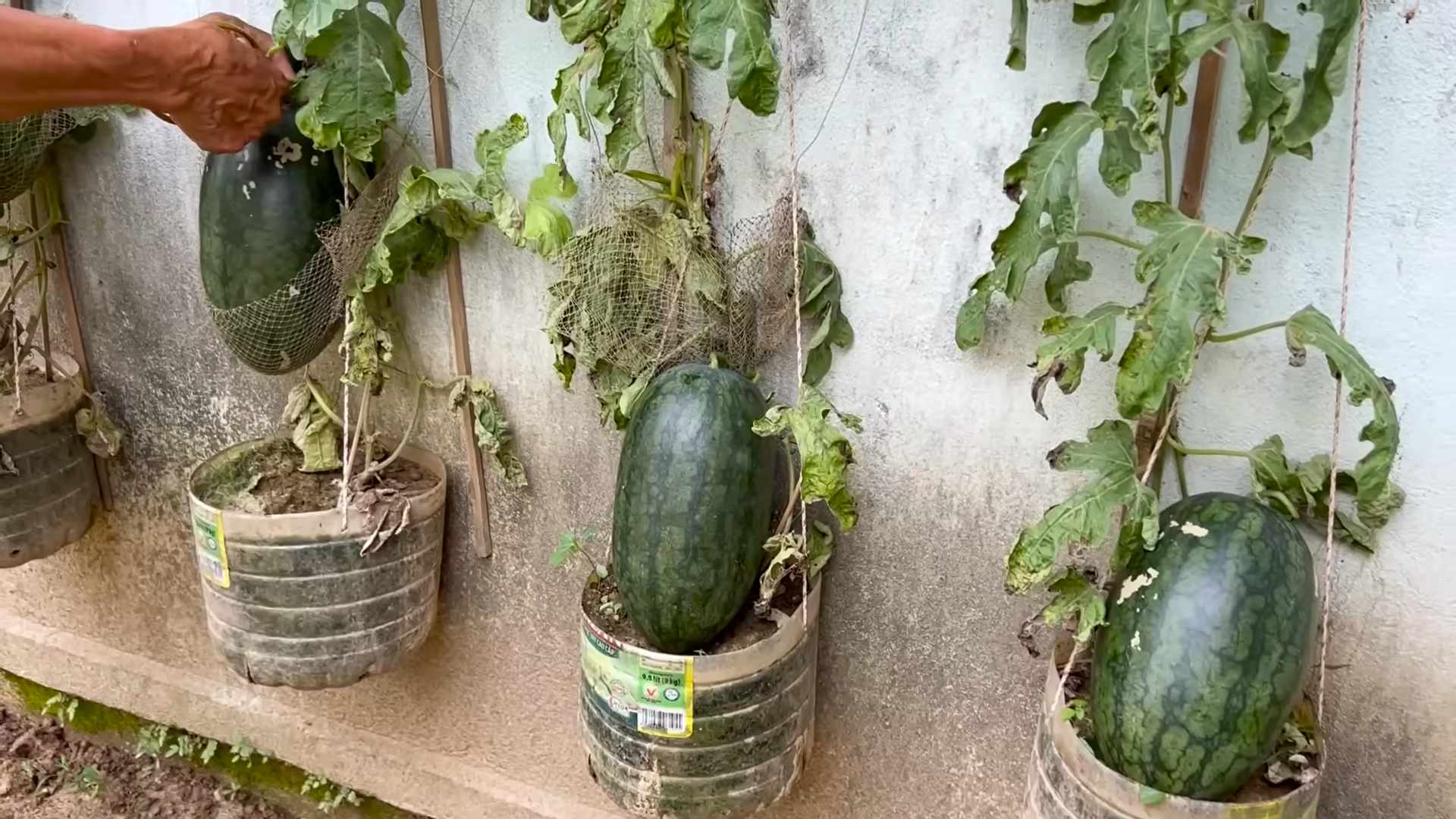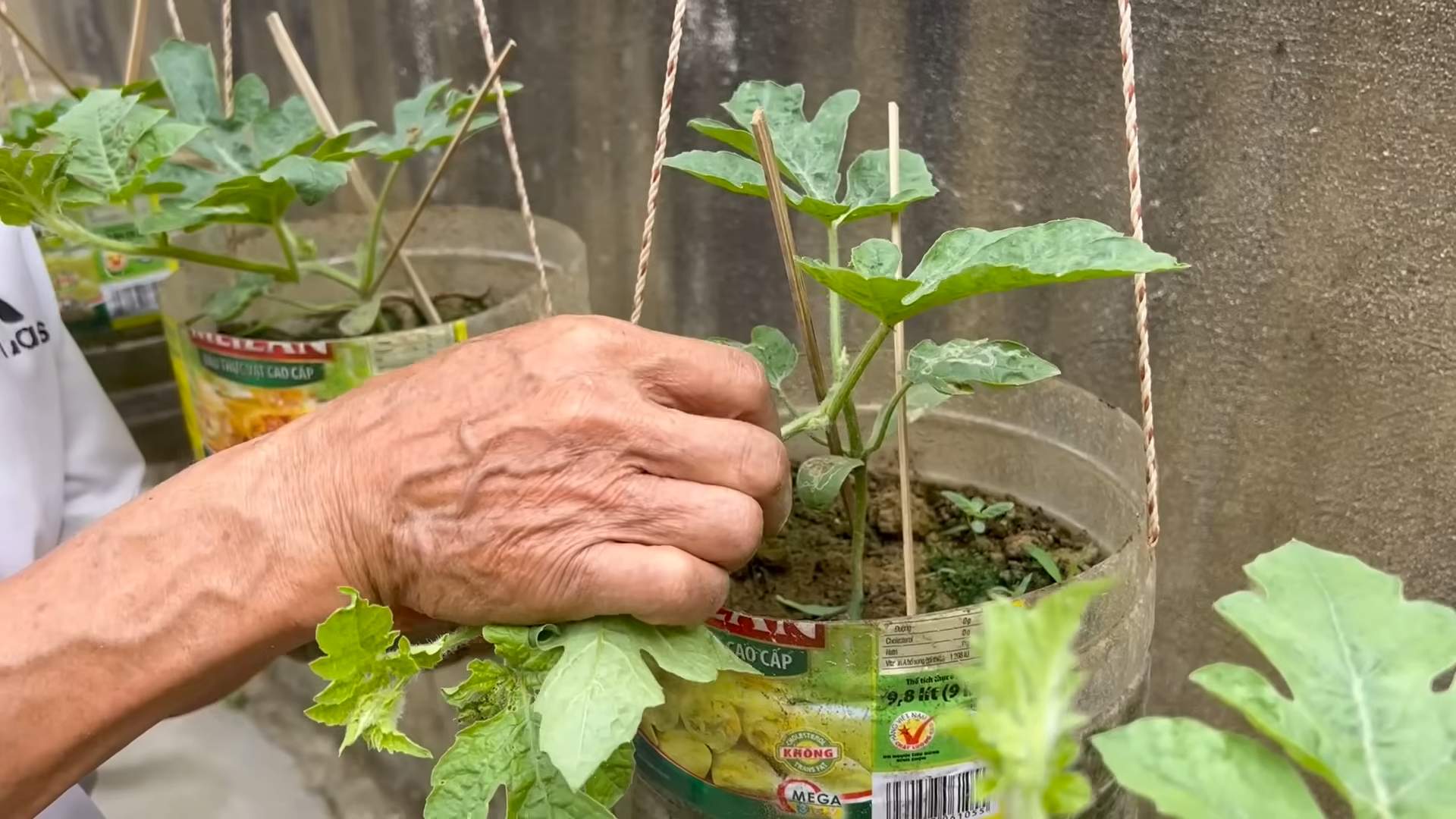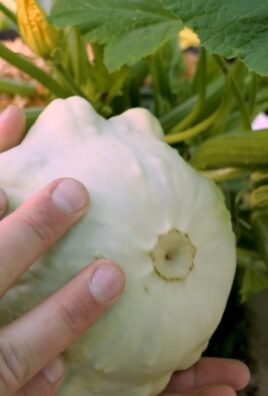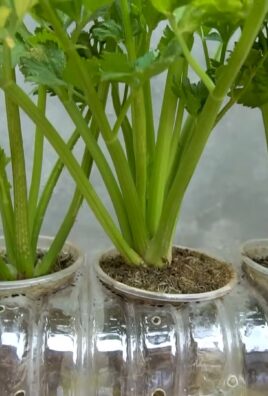Watermelon Growing Tips: Dreaming of biting into a juicy, homegrown watermelon this summer? I know I am! There’s nothing quite like the sweet, refreshing taste of a watermelon you’ve nurtured from a tiny seed to a sprawling vine. But let’s be honest, growing these giants can feel a little intimidating. That’s why I’ve put together this guide packed with easy DIY tricks and hacks to help you cultivate the best watermelons you’ve ever tasted, right in your own backyard!
Watermelons have a rich history, dating back thousands of years to Africa. Ancient Egyptians even depicted watermelons in their art and placed them in tombs to nourish the deceased in the afterlife! Today, this beloved fruit is enjoyed worldwide, and with these simple tips, you can easily join the ranks of successful home gardeners.
Why do you need these watermelon growing tips? Because store-bought watermelons often lack the intense flavor and sweetness of homegrown varieties. Plus, you’ll know exactly what went into growing yours – no mystery chemicals or pesticides! I’ll share my secrets for choosing the right varieties, preparing your soil, providing the perfect amount of water and sunlight, and even protecting your precious melons from pests and diseases. Get ready to impress your friends and family with your watermelon-growing prowess!

Growing Watermelons: A Beginner’s Guide to Sweet Success
Hey there, fellow gardening enthusiasts! I’m so excited to share my watermelon growing secrets with you. There’s nothing quite like biting into a juicy, homegrown watermelon on a hot summer day. It’s a rewarding experience, and trust me, even if you’re a beginner, you can absolutely do this! This guide will walk you through everything you need to know, from choosing the right variety to harvesting your prize-winning melon.
Choosing the Right Watermelon Variety
Before we get our hands dirty, let’s talk about watermelon varieties. There are tons of options, and the best one for you will depend on your climate, garden size, and personal preferences.
* **For Small Gardens:** If you’re short on space, consider bush or dwarf varieties like ‘Sugar Baby’ or ‘Bush Sugar Baby’. They produce smaller melons on compact vines.
* **For Warm Climates:** ‘Charleston Gray’ and ‘Crimson Sweet’ are popular choices for warmer regions, known for their disease resistance and delicious flavor.
* **For Cooler Climates:** ‘Blacktail Mountain’ and ‘Golden Midget’ are early-maturing varieties that can thrive in shorter growing seasons.
* **Seedless Watermelons:** If you prefer seedless watermelons, ‘Triploid’ varieties are the way to go. Just remember that they need a pollinator variety planted nearby to produce fruit.
* **Novelty Watermelons:** Want something different? Try growing yellow or orange-fleshed watermelons like ‘Orange Tendersweet’ or ‘Yellow Doll’.
I personally love growing ‘Sugar Baby’ because it’s reliable, produces sweet melons, and doesn’t take up too much space in my garden.
Preparing Your Garden for Watermelons
Watermelons are heavy feeders, meaning they need plenty of nutrients to grow big and juicy. They also need lots of sunshine and well-drained soil. Here’s how to prepare your garden for success:
* **Sunlight:** Choose a location that receives at least 6-8 hours of direct sunlight per day.
* **Soil:** Watermelons prefer sandy loam soil that is well-draining. If your soil is heavy clay, amend it with compost, aged manure, or peat moss to improve drainage and fertility.
* **Soil pH:** Aim for a soil pH between 6.0 and 6.8. You can test your soil pH with a home testing kit or send a sample to your local agricultural extension office.
* **Fertilizing:** Before planting, amend the soil with a generous amount of compost and a balanced fertilizer (e.g., 10-10-10). Watermelons need plenty of nitrogen early in their growth to develop strong vines, followed by phosphorus and potassium for fruit production.
Planting Watermelon Seeds or Transplants
You can start watermelon seeds indoors 3-4 weeks before the last expected frost, or you can direct sow them in the garden after the soil has warmed up to at least 70°F (21°C).
* **Starting Seeds Indoors:**
1. Fill seed trays or small pots with a seed-starting mix.
2. Sow seeds about 1 inch deep and water gently.
3. Keep the soil moist and warm (around 80-85°F or 27-29°C). A heat mat can help with germination.
4. Once the seedlings have developed their first true leaves, transplant them into larger pots.
5. Harden off the seedlings by gradually exposing them to outdoor conditions for a week before transplanting them into the garden.
* **Direct Sowing Seeds:**
1. Create small mounds of soil about 3-4 feet apart.
2. Sow 4-5 seeds per mound, about 1 inch deep.
3. Water gently and keep the soil moist.
4. Once the seedlings emerge, thin them to the strongest one or two plants per mound.
* **Transplanting Seedlings:**
1. Dig a hole slightly larger than the root ball of the seedling.
2. Gently remove the seedling from its pot and loosen the roots.
3. Place the seedling in the hole and backfill with soil.
4. Water thoroughly.
5. Space transplants 3-4 feet apart.
I usually start my watermelon seeds indoors to get a head start on the growing season, especially since I live in an area with a shorter summer.
Caring for Your Watermelon Plants
Watermelons need consistent watering, fertilization, and protection from pests and diseases.
* **Watering:** Water deeply and regularly, especially during hot, dry weather. Watermelons need about 1-2 inches of water per week. Avoid overhead watering, as this can promote fungal diseases. Drip irrigation or soaker hoses are ideal.
* **Fertilizing:** Side-dress your watermelon plants with a fertilizer high in phosphorus and potassium when the vines start to run and again when the fruits begin to develop. I like to use a fertilizer specifically formulated for melons.
* **Weeding:** Keep the area around your watermelon plants free of weeds, which can compete for nutrients and water. Mulching with straw or black plastic can help suppress weeds and retain moisture.
* **Pollination:** Watermelons need to be pollinated by bees to produce fruit. If you’re not seeing many bees in your garden, you can hand-pollinate the flowers. To do this, use a small paintbrush to transfer pollen from the male flowers (which have a long, thin stem) to the female flowers (which have a small, immature fruit at the base).
* **Pest Control:** Watch out for common watermelon pests like aphids, squash bugs, and cucumber beetles. You can control these pests with insecticidal soap, neem oil, or by hand-picking them off the plants.
* **Disease Control:** Watermelons are susceptible to fungal diseases like powdery mildew and anthracnose. To prevent these diseases, provide good air circulation, avoid overhead watering, and apply a fungicide if necessary.
I’ve found that consistent watering and regular fertilization are key to growing big, healthy watermelons. I also like to check my plants regularly for pests and diseases so I can catch any problems early.
Protecting Your Watermelons
As your watermelons grow, you’ll want to protect them from pests, diseases, and sunburn.
* **Elevate the Fruits:** Place a piece of cardboard, straw, or wood under each watermelon to prevent it from rotting on the ground and to protect it from soil-borne diseases.
* **Sun Protection:** If your watermelons are exposed to intense sunlight, you can shade them with a piece of cloth or cardboard to prevent sunburn.
* **Pest Protection:** Use netting or row covers to protect your watermelons from pests like birds and rodents.
I learned the hard way that elevating the fruits is essential! I lost a few watermelons to rot before I started using cardboard.
Harvesting Your Watermelons
Knowing when to harvest your watermelons can be tricky, but here are a few signs to look for:
* **The tendril closest to the fruit turns brown and dries up.**
* **The spot where the watermelon rests on the ground turns from white to yellow.**
* **The watermelon sounds dull and hollow when you thump it.**
* **The rind becomes dull and loses its shine.**
The “thump” test is the one I rely on the most. It takes some practice, but once you get the hang of it, you’ll be able to tell when a watermelon is ripe just by the sound it makes.
To harvest your watermelon, use a sharp knife to cut the stem close to the fruit. Be careful not to damage the watermelon.
Enjoying Your Homegrown Watermelons
Congratulations! You’ve successfully grown your own watermelons. Now it’s time to enjoy the fruits (or should I say, melons) of your labor.
* **Chill your watermelon in the refrigerator for a few hours before serving.**
* **Cut it into wedges or cubes and enjoy it as a refreshing snack.**
* **Use it to make watermelon juice, smoothies, or salads.**
* **Share it with your friends and family!**
There’s nothing quite like the taste of a homegrown watermelon. It’s so much sweeter and more flavorful than store-bought watermelons. I hope this guide has inspired you to try growing your own watermelons. With a little bit of effort, you can enjoy a bountiful harvest of sweet, juicy melons all summer long. Happy gardening!

Conclusion
So, there you have it! Mastering these simple yet effective watermelon growing tips can transform your backyard into a personal watermelon patch, overflowing with juicy, sweet goodness. Forget those bland, store-bought watermelons that lack flavor and character. With a little effort and these proven techniques, you’ll be harvesting watermelons that are bursting with flavor and far superior to anything you can buy.
Why is this DIY approach a must-try? Because it puts you in control. You control the soil, the nutrients, the watering schedule, and ultimately, the quality of your harvest. You’ll know exactly what went into your watermelon, ensuring it’s free from harmful chemicals and packed with natural sweetness. Plus, there’s an undeniable satisfaction that comes from nurturing a plant from seed to fruit, a connection to nature that’s both rewarding and grounding.
But don’t stop there! Experiment with different watermelon varieties to find your personal favorite. Try growing seedless watermelons for convenience, or heirloom varieties for unique flavors and colors. Consider companion planting with herbs like basil or marigolds to deter pests and enhance growth. You can even explore vertical gardening techniques to maximize space in smaller gardens. The possibilities are endless!
We’ve covered everything from seed starting and soil preparation to pollination and pest control. We’ve armed you with the knowledge and the tools to succeed. Now, it’s your turn to put these watermelon growing tips into action.
Don’t be intimidated if you’re a beginner. Gardening is a journey of learning and discovery. There will be challenges along the way, but the reward of biting into a homegrown watermelon is well worth the effort.
We are confident that by following these guidelines, you’ll be well on your way to enjoying a bountiful watermelon harvest. So, grab your seeds, get your hands dirty, and prepare to be amazed by the fruits (or rather, the watermelons!) of your labor.
We encourage you to try these watermelon growing tips and share your experiences with us! Let us know what worked for you, what challenges you faced, and any tips you discovered along the way. Share your photos and stories in the comments below. We can’t wait to see your amazing watermelon creations! Happy gardening!
Frequently Asked Questions (FAQ)
What is the best time to start watermelon seeds?
The ideal time to start watermelon seeds indoors is about 6-8 weeks before the last expected frost in your area. This gives the seedlings a head start and allows them to develop a strong root system before being transplanted outdoors. If you live in a warmer climate with a longer growing season, you can direct sow the seeds directly into the ground after the last frost has passed and the soil has warmed up to at least 70°F (21°C). Check your local weather forecasts and planting calendars for the most accurate timing for your region.
What kind of soil is best for growing watermelons?
Watermelons thrive in well-drained, sandy loam soil that is rich in organic matter. The soil should have a slightly acidic to neutral pH level, ideally between 6.0 and 6.8. Before planting, amend the soil with compost, aged manure, or other organic materials to improve drainage, fertility, and water retention. Avoid heavy clay soils, as they can become waterlogged and hinder root growth. If you have clay soil, consider growing watermelons in raised beds or containers filled with a suitable potting mix.
How much sunlight do watermelons need?
Watermelons are sun-loving plants and require at least 6-8 hours of direct sunlight per day to produce sweet, juicy fruits. Choose a planting location that receives full sun throughout the day. If your garden is partially shaded, try to position the watermelon plants so that they receive the most sunlight possible. Insufficient sunlight can result in smaller, less flavorful watermelons.
How often should I water my watermelon plants?
Watermelons need consistent watering, especially during hot, dry weather. Water deeply and regularly, aiming to keep the soil consistently moist but not waterlogged. Water at the base of the plants to avoid wetting the foliage, which can increase the risk of fungal diseases. As the watermelons mature, you can gradually reduce the amount of watering to encourage the fruits to ripen and develop a sweeter flavor. A good rule of thumb is to water deeply once or twice a week, depending on the weather conditions.
How do I know when my watermelons are ripe?
Determining when a watermelon is ripe can be tricky, but there are several indicators to look for. First, check the tendril closest to the watermelon stem. When this tendril turns brown and dries out, it’s a sign that the watermelon is nearing ripeness. Second, examine the underside of the watermelon where it rests on the ground. This spot, known as the “ground spot,” should turn from white to a creamy yellow color. Finally, give the watermelon a gentle thump. A ripe watermelon will sound hollow and deep, while an unripe watermelon will sound dull and solid. With practice, you’ll develop a feel for identifying ripe watermelons.
What are some common pests and diseases that affect watermelons?
Watermelons can be susceptible to various pests and diseases, including aphids, squash bugs, vine borers, powdery mildew, and fusarium wilt. To prevent pest and disease problems, practice good garden hygiene, such as removing weeds and debris, and providing adequate spacing between plants to improve air circulation. Inspect your plants regularly for signs of pests or diseases and take action promptly. Organic pest control methods, such as insecticidal soap or neem oil, can be effective for controlling aphids and other pests. For fungal diseases, consider using a copper-based fungicide or a baking soda spray. Crop rotation can also help to prevent soilborne diseases.
Can I grow watermelons in containers?
Yes, you can grow watermelons in containers, but you’ll need to choose a large container (at least 20 gallons) and select a compact or bush-type watermelon variety. Use a high-quality potting mix that is well-draining and rich in organic matter. Provide adequate sunlight, water, and fertilizer to support the plant’s growth. You may also need to provide support for the vines as they grow. Container-grown watermelons may not produce as large or as many fruits as those grown in the ground, but they can still provide a delicious and rewarding harvest.
How can I improve the sweetness of my watermelons?
Several factors can influence the sweetness of watermelons, including sunlight, water, and nutrients. Ensure that your watermelon plants receive at least 6-8 hours of direct sunlight per day. Water deeply and regularly, but reduce watering as the fruits mature to concentrate the sugars. Fertilize with a balanced fertilizer during the early stages of growth, and then switch to a fertilizer that is higher in potassium as the fruits begin to develop. Avoid over-fertilizing with nitrogen, as this can promote leafy growth at the expense of fruit production. Finally, be patient and allow the watermelons to ripen fully on the vine before harvesting.
What are some good companion plants for watermelons?
Companion planting can help to improve the growth and health of watermelons by attracting beneficial insects, repelling pests, and improving soil conditions. Some good companion plants for watermelons include:
* **Marigolds:** Repel nematodes and other soil pests.
* **Basil:** Repels aphids, whiteflies, and other insects.
* **Nasturtiums:** Attract aphids away from watermelon plants.
* **Radishes:** Deter cucumber beetles and other pests.
* **Oregano:** Attracts beneficial insects and repels pests.
* **Beans:** Fix nitrogen in the soil, benefiting watermelon growth.
Avoid planting watermelons near potatoes or tomatoes, as they can compete for nutrients and attract similar pests and diseases.
How do I hand-pollinate watermelons?
If you’re having trouble with pollination, you can hand-pollinate your watermelon flowers. Watermelons have separate male and female flowers on the same plant. The male flowers typically appear first, followed by the female flowers. To hand-pollinate, use a small paintbrush or cotton swab to collect pollen from the male flower and transfer it to the stigma of the female flower. The female flower can be identified by the small, immature watermelon at the base of the flower. Hand-pollinate in the morning, when the pollen is most viable.




Leave a Comment